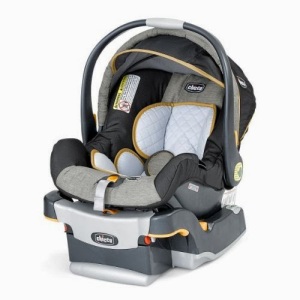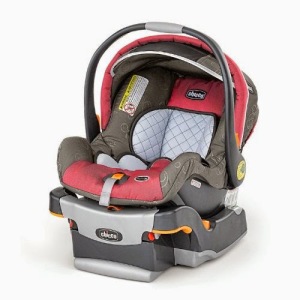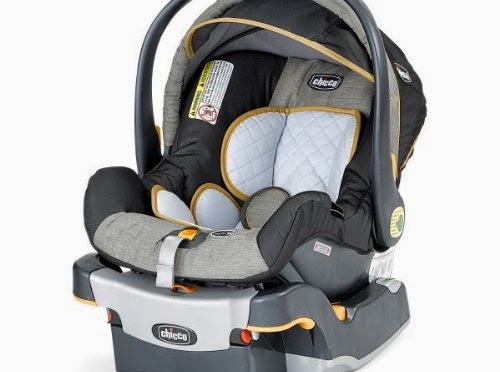The Chicco KeyFit 30 is one of the most popular infant car seats available today in the United States, which is part of why I was eager to take a closer look at it. How easy is it to install? What kinds of features does it offer over a number of similar seats in its price range (e.g., the Britax B-Safe 35)? And of course, how good of a job does it do keeping kids safe? These are some of the questions I tried to answer in this review of the KeyFit 30.
2018 update: The KeyFit 30 continues to be one of my favorite infant seats on the market, because it’s reliable, affordable, easy to install, and narrow enough to fit 3 across in pretty much any vehicle. The weight and height limits remain the same, although fabric options have been updated slightly. Remember that the cheapest seats aren’t necessarily the best ones–the ones that make it easy to live the rest of your life while knowing your kids are safe–those are worth spending a bit more on. The KeyFit is one of those seats.
Chicco KeyFit 30 – What’s the big deal?


The Chicco KeyFit 30 isn’t the kind of seat I’d typically review, given my preference for convertibles and combination seats, but functionality is what’s important, and in terms of functionality, this is one of the most impressive seats on the market.
It’s an infant car seat, which means it can be used in one configuration: as a rear-facing infant seat. It does not forward face; for that, you’ll need a convertible.
It’s one of the newest infant seats from Chicco, and aims to improve child safety by increasing the odds parents have of correctly installing and using car seats from day one. Is it worth it? Read on to find out!
Chicco KeyFit 30 Limits for Weight and Height
Rear-facing: 4-30 pounds. Your child’s head should not reach past 1″ below the top of the main shell. There is also a 30″ height limit for the child.
Of course, as a good parent, you’re not going to stop at 30 lbs, since research into car safety indicates children should remain rear-facing for as long as possible (the average is 4 years in Sweden, which posts the lowest child fatality rate on Earth), and after rear-facing, the child should remain forward-facing as long as possible.
Buy the Chicco KeyFit 30 on Sale with Free Shipping at Amazon here.
Dimensions of the Chicco KeyFit 30
The seat is 17″ wide at its widest point and 22″ high. The seat weighs 9.6 pounds, which makes it the lightest seat I’ve reviewed so far. Of course, being an infant seat, it should be much lighter than a convertible.
Using the Chicco KeyFit 30
Chicco calls the Keyfit 30 the easiest infant car seat a parent can install, and goes as far as to call it the highest rated infant car seat throughout the United States. These are big claims to back up, but I’d say they’re pretty close to accurate. I was surprised myself until I took a look at the seat. What makes the Keyfit so awesome? It’s a seat that was clearly thought out well ahead of time, and that led to a good design and solid construction. Here’s what it’s like to use it.
The Keyfit 30 covers are machine washable (use the cold water cycle on delicate with a mild detergent, and line dry them). The seat can be detached from its base and attached to Chicco strollers, which makes it easy to transport your children while on the go. The harness adjuster is very, very smooth, which helps in tightening and loosening straps. The manual is available in English and Spanish and makes sense in both languages. You can achieve a good install with either the seat belt or with lower LATCH anchors. Don’t use both, of course. The seat may be installed with or without the base. I like the base because it makes it a snap (literally) to install and remove the seat, which is crucial for getting a newborn or young infant out of a vehicle or into one without waking him or her.
Something else I like about the Keyfit 30 is that it is preemie friendly. There are a lot of seats that require a lot of hoops such as blanket rolling to make work with premature infants, and any mother who has purchased, bought, and returned several car seats to and from the NICU in effort to find a seat that makes a good fit knows how thankless of a task that is. However, the Keyfit 30 fits preemies easily (as long as they weigh at least 4 pounds), which is a blessing.
Buy the Chicco KeyFit 30 on Sale with Free Shipping at Amazon here.
Why Buy the Chicco KeyFit 30?
The Chico KeyFit 30 is not designed to help you rear-face a child until the cows come home. What it does well is provide parents with a convenient and nearly fool-proof method of getting their child safely from the hospital and around for the first few months of life. After that, I’d recommend replacing it with a convertible seat with the highest RF limits you can find. In other words, look for these seats. Remember, every pound is precious, as the longer you rear-face, the safer your child is. In the US, parents tend to turn their children around into the line of fire at 1. In Sweden, this typically isn’t done until 4. Children in Sweden are far less likely to die in car crashes than children in the US. It makes that much of a difference.
If ERF is what’s most important, then you might wonder why I’d suggest a seat that doesn’t come anywhere close to the best ERF limits. That’s because infant seats aren’t designed to RF forever. They’re for convenience! A class A convertible like a Foonf weighs more than 30 pounds; add the 7 pounds of a newborn and there’s no way you’re going to take that seat and child anywhere if it’s all you have as a child seat.
In contrast, with a seat like the Keyfit 30, you buy it packaged with a stroller, such as with the Keyfit 30 Travel System, and use the seat and stroller to transport your child when walking, and move the seat with your newborn about without waking up your child. Later, as your child gains in weight, you’ll naturally stop using the infant seat and start using the stroller or a good baby carrier to transport him or her, and when s/he’s in the car, you’ll use a high quality convertible car seat, and then later a combination seat. That’s the easiest way to navigate the practicalities of weight, children, car seats, and transportation. Start with the infant seat and stroller, or infant seat and carrier, and transition to the stroller or carrier and convertible seat.
I recommend the Chicco Keyfit 30 wholeheartedly. You can buy the KeyFit 30 in a range of colors here. Canadians can buy the KeyFit 30 by itself or with a range of travel systems here.
 If you find my information on best practices in car and car seat safety helpful, you can do your shopping through this Amazon link. Canadians can shop here for Canadian purchases. Have a question or want to discuss best practices? Join us in the forums!
If you find my information on best practices in car and car seat safety helpful, you can do your shopping through this Amazon link. Canadians can shop here for Canadian purchases. Have a question or want to discuss best practices? Join us in the forums!

